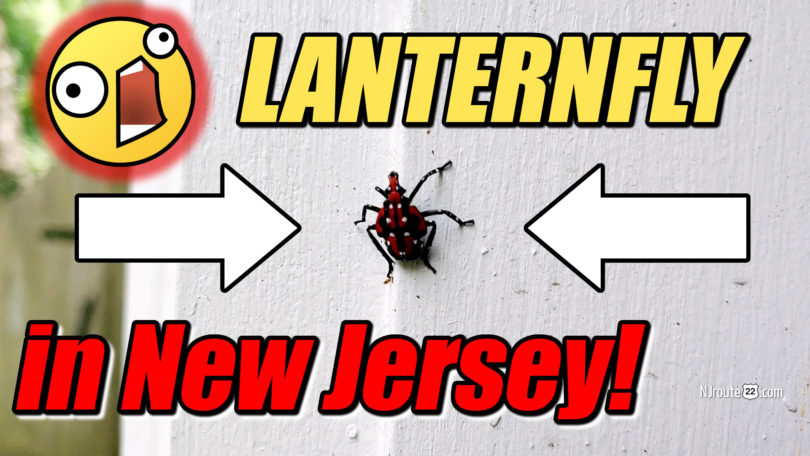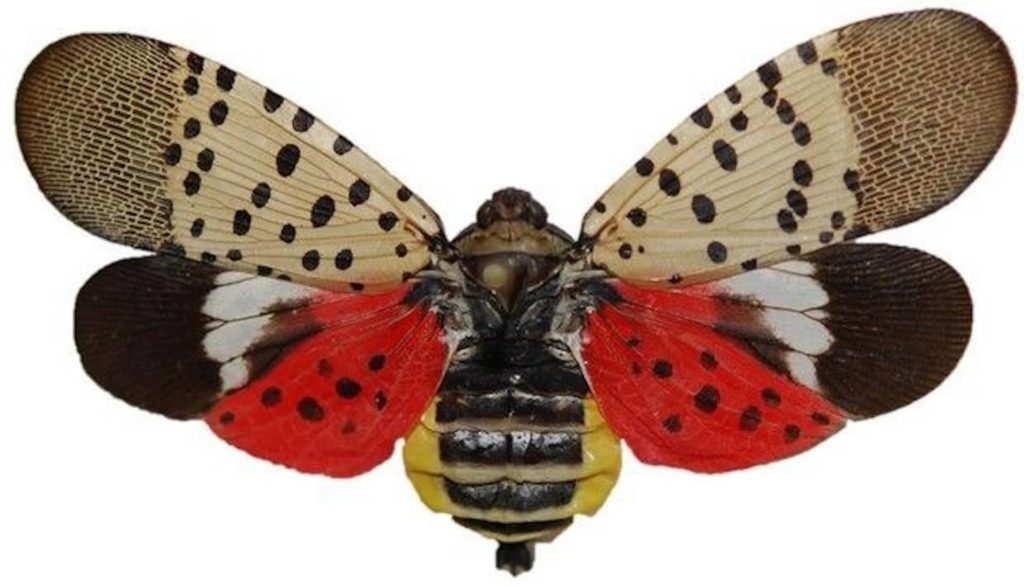Spotted Lanternfly in New Jersey
Apparently the Spotted Lanternfly (or referred to as “Lanterflies” in the plural) is a big thing this summer in the northeast.
The buzz is building – and apparently various arborists and other environmental agencies are struggling about what to do about these new pests. Word on the street is that this (like Stinkbugs) is another lovely byproduct of China and other far-east countries. Seems like a natural side-effect of buying things outside of your home country, right?
Here’s a video we shot a few days ago. Note that the red Laternflies are considered to be mature adults, while the black ones are the “babies.” Who the heck knows.
Today’s NJroute22.com VLOG – is this video short:
Spotted Lanternflies
While ticks and mosquitos can be dangerous pests, there’s another not-so-local insect that has made its way to Northeast Pennsylvania, and it can pose a threat to both farmers and residential properties. The spotted lanternfly, or lycorma delicatula, has invaded parts of southern and northern Pa., New Jersey, and has stretched as far as Virginia.
As the warm weather returns, the potential danger rises and it’s crucial for everyone to keep an eye out for this invasive species. Here are some tips on how to look for spotted lanternfly and what to do if you should see one.
What Is the Spotted Lanternfly?
The spotted lanternfly is an invasive planthopper insect native to China, India, and Vietnam. The adult insect is approximately 1” long and about a ½ inch wide. Their front wing is grey with black spots, with black blocked outlined wingtips, while their hind wings are red and black with a white band. Spotted lanternflies’ legs and heads are black, and their abdomens are yellow with broad black bands. The immature lanternflies are smaller, black, and covered in white spots. They develop red patches as they grow.
Why Are Spotted Lanternflies A Problem?
It is unknown whether the spotted lanternfly is physically harmful to humans or animals. However, these insects feed on plants and trees. This invasive species feeds on over 70+ plants, including important forestry and agricultural crops. They are particularly fond of apples, grapes, and other vegetation, but the Tree of Heaven is strongly preferred.
Attacked trees develop weeping wounds; they are often greyish or black. Spotted lanternflies leave a similarly colored trail along the trunk of the tree. These weeping wounds attract many other insects, including wasps and ants.
Adult lanternflies lay egg masses on host trees and on nearby smooth surfaces. They can attach these masses to almost anything: vehicles, furniture, structures, stones, and many more spots. This makes it difficult to track where they are, and even easier to bring them somewhere new. Newly laid eggs masses have grey mud-like covering.
This invasive species is a threat to Pennsylvania’s grape, tree-fruit, hardwood, nursery, and landscape industries, which generate agricultural crops and forest products. Additionally, spotted lanternflies can cause damage to high-value ornamentals in home landscapes and can affect the quality of life.
Where Is The Spotted Lanternfly Threat?
Spotted lanternflies were first discovered in Berks County, PA in 2014. The infestation spread throughout 14 counties in southeastern PA, which the Pennsylvania Department of Agriculture has designated as a quarantine zone. In 2017, spotted lanternflies were found in Fredrick County, Virginia. The following year in 2018, three New Jersey counties (Mercer, Warren, and Hunterdon) were quarantined for spotted lanternfly infestation. Currently, three local counties included in the quarantine are Schuylkill, Carbon, Monroe.
Hitchhikers by nature, spotted lanternflies are very easy to miss. They can be on anything: your car, your clothes, or any item you may want to transfer out of a quarantined zone. To move anything from a zoned area, you must inspect everything for egg masses, juveniles, and adults.
What’s Being Done To Stop Spotted Lanternfly?
Research may have found the first breakthrough in the attempt to stop the spread. Recently, a fungus was found locally. There are two naturally occurring fungi that have killed the lanternflies at a park near Reading. The research continues, but this is the first possible enemy that may be the key to fighting this invasive species.
These insects have wiped out crops, trees, and vegetation in all quarantined areas. With the discovery of these two naturally occurring funguses in a park in Berks County near Reading, there is some hope. This is not, however, a final solution.
What Can You Do To Stop The Invasion?
The best way to combat this invasion is to be vigilant. Follow the necessary precautions issued by the Pennsylvania Department of Agriculture and Penn State University. Check outdoor items for spotted lanternfly egg masses, including anything you move inside between seasons. Scrape egg masses into a plastic zippered bag filled with hand sanitizer, then zip the bag shut. Take the proper steps to dispose of it.
Inspect your trees and plants for signs of this pest. Dusk and nighttime are typically when these insects tend to gather in large groups on trunks or stems of plants. Inspect trees (in particular, tree of heaven) bricks, stone, and other smooth surfaces for egg masses. Most importantly, should you find evidence of an infestation, report it to the experts. Together, we can stop the spread of spotted lanternflies and protect our agriculture.
(h/t The Pest Rangers for the information)









